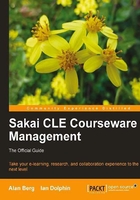
A brief history
Sakai is relatively young, but has strong roots and has grown fast.
In late 2003, four universities — MIT, Michigan, Stanford, and Indiana — saw a common cause to jointly develop an Open Source environment to support learning, research, and other forms of collaboration required by a modern educational institution. They agreed to contribute labor to the tune of $4.4 million, and slightly later that year, the Andrew W. Mellon Foundation (http://mellon.org) seeded another $2.2 million.
Tip
The project did not need to start from scratch; the University of Michigan already had a significant codebase and, just as importantly, a conceptual framework and essential experience from the creation of its own set of tools called Chef.
The Java-based tool creation
For those of you who are interested in tool creation, the online Development Environment Setup document (http://bugs.sakaiproject.org/confluence/display/BOOT/Development+Environment+Setup+Walkthrough) is a necessary read.
Chef tools encompassed a subset of the Sakai functionality and were mature, with first deployments as early as 2001. The original Sakai codebase also included code from the other universities (including coursework and assessments from Stanford) and OSIDs (an set of standard coding APIs and architecture for educational purposes based on Service Oriented Architecture) from the OKI project (http://okiproject.org).
The first phase of Sakai was the so-called "best of refactoring", during which the code was unified and the main framework put into place.
Sakai 1.0
The newly-formed team officially announced the Sakai project at Educause (http://educause.edu) in November 2003, and in June 2004, the team released Sakai 1.0. Date-driven development cycles resulted in a high evolution rate and both Michigan and Indiana rolled out Sakai to their students and instructor audiences at the end of 2004 and during 2005.
For the Sakai project to survive beyond the first two years, it needed to move away from grant funding towards a model in which the community and software were self-sustaining. The vehicle for this transition was the Sakai Foundation, to which, in their good judgment and self-interest, individual organizations transferred copyrights and resources.
A separate project, the Open Source Portfolio (OSP) initiative, was next merged into the Sakai codebase and it improved the overall value of both Sakai and OSP products by enriching integration, as well as allowing a combined use of resources for quality assurance and tool building.
The foundation administers a voluntary membership program, collecting dues from over 120 institutions that choose to make this additional commitment to sustain Sakai. Recognizing early, the significant role that commercial support can play in helping academic organizations develop and deploy, the Foundation created its Sakai Commercial Affiliates (SCA) program to foster commercial partnerships.
Present day
Currently, there is a healthy ecosystem with commercial partners providing a variety of support, from hosting to customizations and tool building. This increases the range of options open to an organization adopting Sakai. An adopter can choose to install, configure, and adapt Sakai to its own needs, buy commercial support for in-house deployment, or choose to purchase a customized hosted solution. This flexibility is not a "once and for all" choice; some adopters after their initial deployment of Sakai buy in specialist expertise for specific projects or developments .
There are small start-up companies that specialize in training or turnkey solutions, such as Edia (http://edia.nl) and Airplane (http://aeroplanesoftware.com), and large, more established players such as rSmart (http://www.rsmart.com), Unicon (http://www.unicon.net/), or Longsight (http://www.longsight.com).
Management is not limited to a choice of one, and competition has a strong tendency to lower costs. A list of Sakai Commercial Affiliates can be found on the main Sakai website (http://www.sakaiproject.org).
The goals of the Foundation include helping to understand the needs of the user, sponsoring inter-organizational collaboration and resource sharing, supporting the growth of the community, and keeping decision-making processes as transparent and accessible as possible.